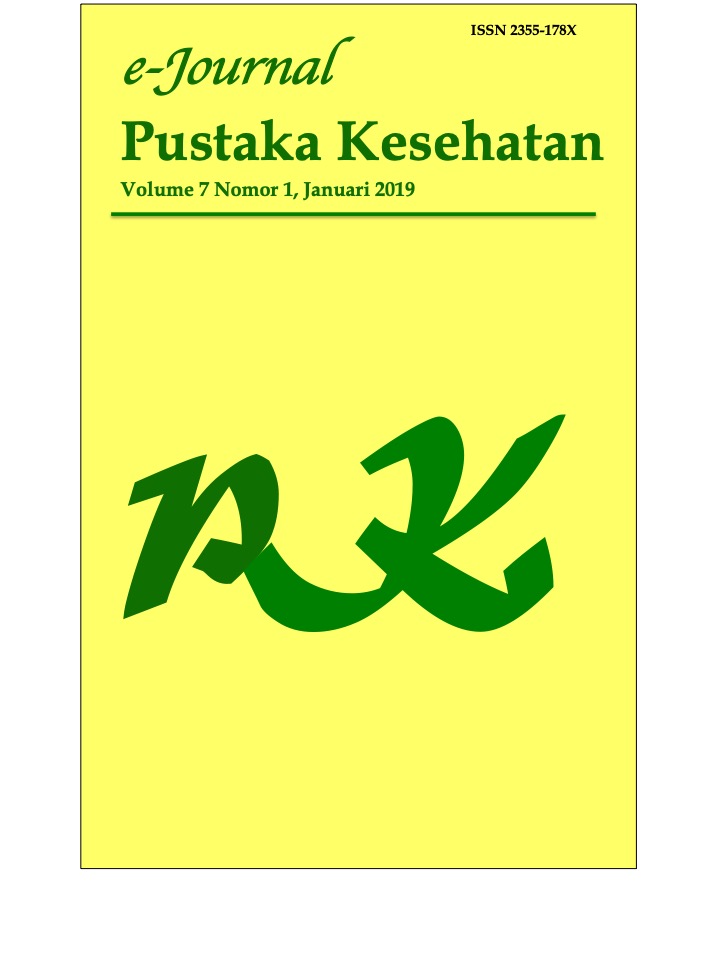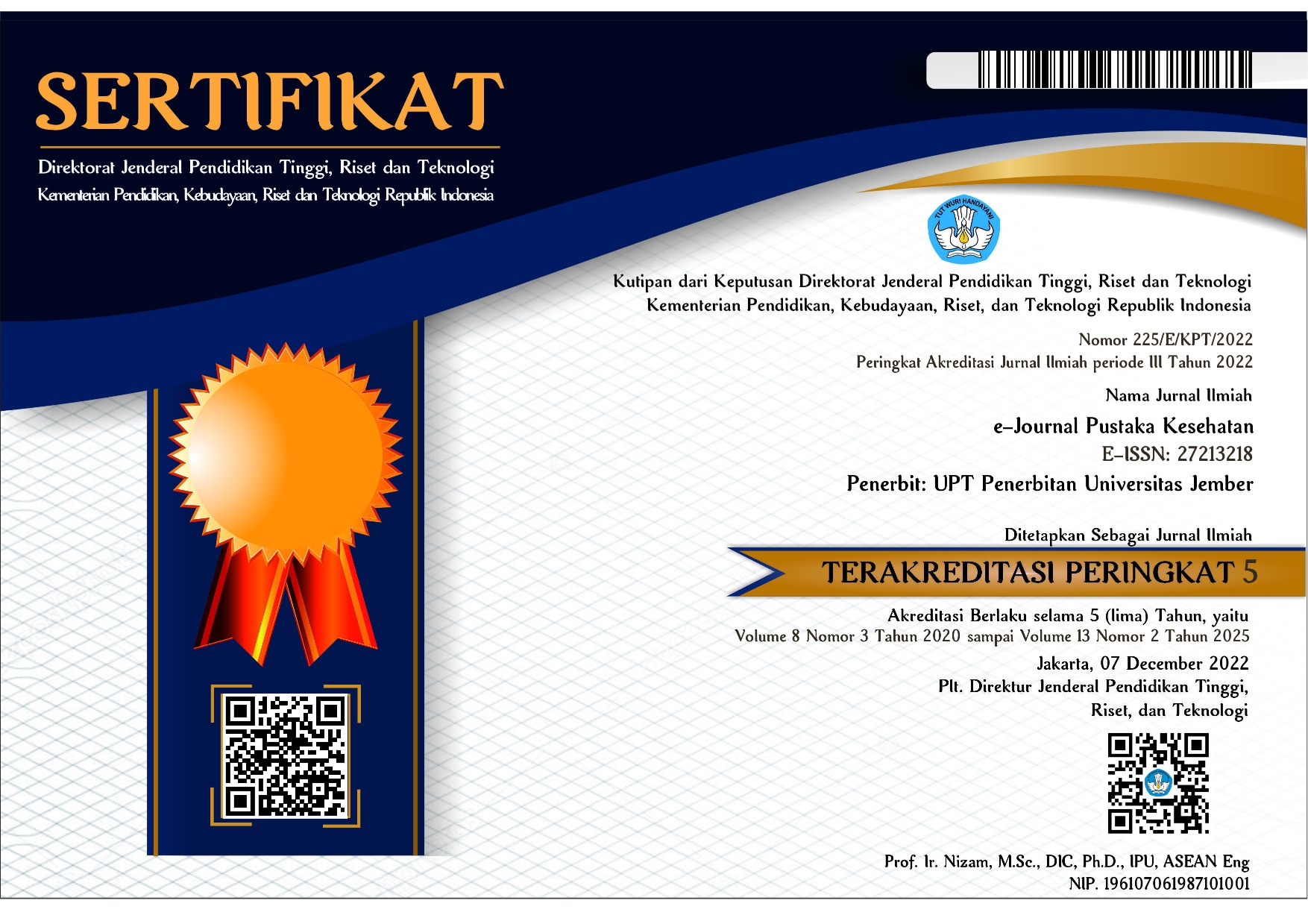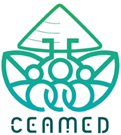Hubungan Sanitasi Lingkungan dengan Kejadian Infeksi Soil Transmitted Helminths pada Anak Sekolah Dasar di Jember
DOI:
https://doi.org/10.19184/pk.v7i1.17591Keywords:
STH infection, environmental sanitation, Primary school childrenAbstract
Poor environmental sanitation is suspected to be one of the causes of soil transmitted helminthes (STH) infection. Environmental sanitation consists of water sources, latrine, sewerage, garbage disposal facilities, and floor type. The objective of this study was to investigate the relationship between environmental sanitation and the incidence of STH infection in primary school children. This was an observational analytic study with cross-sectional design. The subjects were 80 students of two elementary schools in Jember. Stool samples were collected and examined by Kato-Katz method. Data of environmental sanitation was collected by questionnaire and direct observation. Kato-Katz examination showed that 9 samples (11,3%) infected by Ascaris lumbricoides. The majority respondents had not fulfilled requirements of good environmental sanitation. The result of Spearman test showed that there was a significant correlation between STH infection and latrine (p=0,02) but there were no significant relationship between STH infection and environmental sanitation (p = 0.165), gender (p = 0,669), age (p = 0,92), water source (p = 0.084), sewerage (p = 0.146), garbage disposal facilities (p = 0,728), and floor type (p = 0,065).
Downloads
References
[2] Direktorat Jenderal PP&PL Kemenkes RI. Profil Pengendalian Penyakit dan Penyehatan Lingkungan Tahun 2014. Jakarta: Kementerian Kesehatan Republik Indonesia. 2015.
[3] Direktorat Jenderal PP&PL Kemenkes RI. Pedoman Pengendalian Kecacingan. Jakarta: Kementerian Kesehatan Republik Indonesia. 2012.
[4] Habtamu K, Abdissa B, Zeleke M. Prevalence of Necator Americanus Infection and Risk Factor Among School-Age in Mirab Abaya District, South Ethiopia. Asian Pasific Journal of Tropical Disease. 2015. 5(5): 363-368.
[5] Duncan M, Jon L, Beth S, David T. Sanitation and Health. Plos Medicine. 2010. 7(11).
[6] Samuel S, Sri S, Soeyoko. Analisis Model Faktor Resiko yang Mempengaruhi Infeksi Kecacingan yang Ditularkan Melalui Tanah Pada Siswa Sekolah Dasar di Distrik Arso Kabupaten Keerom, Papua. Media Litbangkes. 2015. 25(1):1-14.
[7] Kharis F, Lenie M, Nelly AA. Fakor-faktor yang Berhubungan dengan Kejadian Kecacingan Pada Siswa Sekolah Dasar Negeri Cempaka 1 Kota Banjar Baru. Jurnal Buski. 2013. 4(3):121-127.
[8] Steffen AS, Petra C, Inge K, Dickens OK, et. al. Ascaris lumbricoides Infection and Its Relation to Environmental Factors in Mbeya Region of Tanzania, a Cross-Sectional, Population-Based Study. Plos One. 2014. 9(3).
[9] William EO, Aisha EPS, Michael RK, Tekola E, et al. Association of Community Sanitation Usage with Soil-Transmitted Helminth Infection Among School-Aged Children in Amhara Region, Ethiopia. Parasites & Vectors. 2017. 10(91)
[10] Merieke H, Oliver C, Rachel p, Gabrielle KSC, et al. Shared Sanitation versus Individual Househols Latrines: A Systematic Review of Health Outcomes. Plos One. 2014. 9(4).
[11] Umi M. Hubungan Sanitasi Lingkungan Rumah Terhadap Kejadian Kecacingan Pada Anak Sekolah Dasar. Jurnal Kesehatan. 2017. 10(1): 32-39.
[12] Hildya K, Nuzulia I, Husnil K. Hubungan Sanitasi Lingkungan Rumah dengan Kejadian Ascariasis dan Trichuriasis pada Siswa SDN 29 Purus Padang. Jurnal Kesehatan Andalas. 2015. 4(3): 718-723.
[13] Zakia S, Lymbran T, Ainurrafiq. Faktor-Faktor yang Berhubungan dengan Kejadian Kecacingan pada Siswa Sekolah Dasar Negeri 02 Mawsangka Kabupaten Buton Tengah Tahun 2017. Jurnal Ilmiah Mahasiswa Kesehatan Masyarakat. 2017. 2(7).
[14] Indri R. Prevalensi Infeksi Soil Transmitted Helminths pada Siswa Madrasah Ibtidaiyah Ittihadiyah Kecamatan Gandus Kota Palembang. Syifa’ Medika. 2018. 8(2): 102-107.
[15] WHO. Water Sanitation Hygiene: Water Related Disease. 2017. [sititasi 9 April 2018]. Dari:http://www.who.int/water_sanitation_health/diseases-risks/diseases/ascariasis/en/.
[16] Shelby LS, Niko Y, Ana LS. The geography and scale of soil transmitted helminth infection. Springer International Publishing. 2017.
Downloads
Published
Issue
Section
License
e-Journal Pustaka Kesehatan has CC-BY-SA or an equivalent license as the optimal license for the publication, distribution, use, and reuse of scholarly work. Authors who publish with this journal retain copyright and grant the journal right of first publication with the work simultaneously licensed under a Creative Commons Attribution-ShareAlike 4.0 International License that allows others to share the work with an acknowledgment of the work's authorship and initial publication in this journal.







